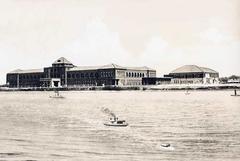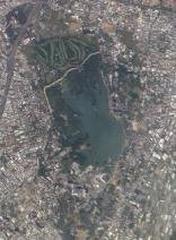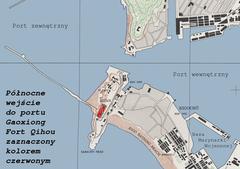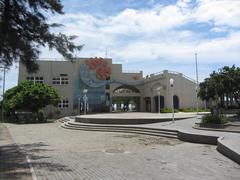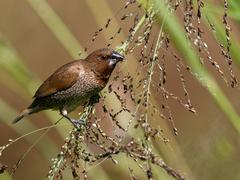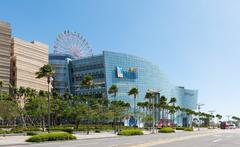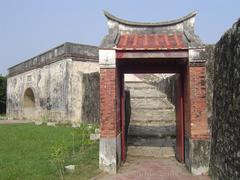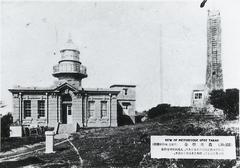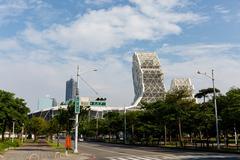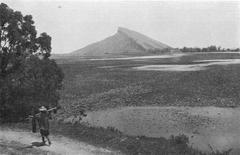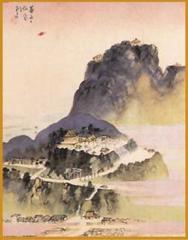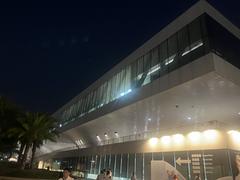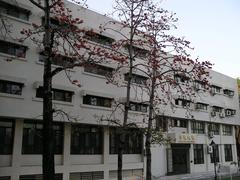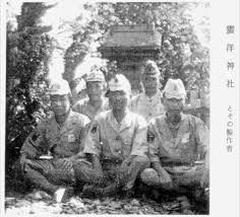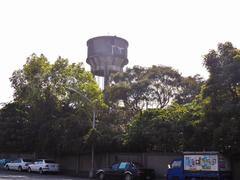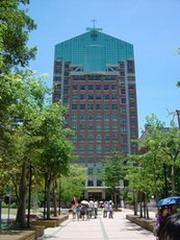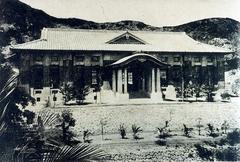Maolin National Scenic Area: Visiting Hours, Tickets, and Travel Guide to Kaohsiung Historical Sites
Date: 04/07/2025
Introduction
Maolin National Scenic Area, located in the mountainous region of southern Taiwan’s Kaohsiung, is a destination celebrated for its spectacular natural beauty, rich indigenous heritage, and unique wildlife phenomena. Renowned for the annual Purple Crow butterfly migration and the vibrant culture of the Rukai and Paiwan peoples, Maolin offers travelers an immersive experience in Taiwan’s ecological and cultural heartland. This comprehensive guide covers everything you need to plan your visit, including key attractions, historical and cultural insights, practical visitor information, and travel tips for a rewarding journey.
Table of Contents
- Overview and Cultural Heritage
- Indigenous Communities and Living Traditions
- Government Preservation and Historical Evolution
- Festivals and Seasonal Events
- Artistic and Architectural Highlights
- Geography and Topography
- Climate and Seasonal Considerations
- Forests, Flora, and Fauna
- Waterfalls, Hot Springs, and Gorges
- Purple Butterfly Valley and Wildlife Observation
- Geological Features
- Hiking Trails and Lookouts
- Visitor Information: Hours, Tickets, Accessibility
- Getting There and Transportation
- Accommodation and Facilities
- Nearby Attractions
- Visuals and Media Resources
- Frequently Asked Questions (FAQ)
- Summary and Recommendations
- References and Useful Links
Overview and Cultural Heritage
Maolin National Scenic Area stretches across parts of Kaohsiung and Pingtung, encompassing rugged terrain, lush forests, and pristine waterways. It is a vital center for indigenous heritage, with ancestral villages and living traditions of the Rukai and Paiwan peoples shaping the region’s identity. Maolin stands out for its rare natural spectacles—most notably, the annual Purple Crow butterfly migration—and its well-preserved tribal architecture, dynamic festivals, and scenic hiking trails (Maolin National Scenic Area Administration; Taiwan Tourism Administration).
Indigenous Communities and Living Traditions
Rukai Slate Houses
Duona Village in Maolin hosts the largest collection of traditional Rukai slate houses in Taiwan—about 30 preserved structures. These stone-slab dwellings are ingeniously adapted to the local environment, offering resilience against humidity and seismic activity. Their distinctive design and craftsmanship are a testament to the Rukai’s harmonious relationship with the mountainous landscape (Taiwan Tourism Administration).
Paiwan and Rukai Interactions
Maolin’s proximity to Paiwan communities has fostered a dynamic cultural exchange. Both tribes are known for animistic beliefs and ancestral veneration, but maintain distinct artistic expressions, such as Rukai beadwork and Paiwan woodcarving. The Taiwan Indigenous Peoples Cultural Park, spanning 82 hectares, is a significant venue for cultural preservation, with reconstructed villages, workshops, and exhibits celebrating indigenous traditions (Maolin National Scenic Area Administration).
Government Preservation and Historical Evolution
The region’s history is marked by centuries of indigenous stewardship, followed by outside influences during the Japanese colonial period and postwar Taiwan. Recognizing the need for cultural preservation, the government established the Taiwan Indigenous Peoples Cultural Park in 1985, which is organized around thematic zones and offers immersive experiences in indigenous arts, architecture, and daily life (Maolin National Scenic Area Administration).
Festivals and Seasonal Events
Maolin’s calendar is rich with traditional festivals and rituals. The most renowned is the Purple Crow Butterfly Festival (November–March), celebrating both the butterfly migration and indigenous ecological knowledge (Maolin National Scenic Area Administration). Other notable events include harvest festivals and the Austronesian Wedding in March, which showcases ritual music and dance (Wikipedia). The Biennial Butterfly Beauty Festival features guided tours and conservation activities (Taiwan Everything).
Artistic and Architectural Highlights
Maolin’s cultural landscapes are adorned with slate houses, bamboo and log structures, and suspension bridges like the Duona Suspension Bridge—one of Taiwan’s longest, offering panoramic valley views (RTaiwanRound). Temples and shrines, including Buddhist sites, reflect a blend of indigenous and imported spiritual traditions (Taiwan Tourism Administration).
Geography and Topography
The scenic area covers about 960 square kilometers, with elevations from 230 to 2,700 meters. The Central Mountain Range, Laonong and Zhuokou Rivers, plateaus, and terraces define its dramatic landscape (Kaohsiung Travel).
Climate and Seasonal Considerations
Maolin has a subtropical monsoon climate, with an average temperature of 22°C and abundant rainfall, especially in the summer. The best time for hiking and butterfly watching is November to March, when the weather is cooler and drier (Smithsonian Magazine).
Forests, Flora, and Fauna
The region’s forests host over 1,000 plant species, including Taiwan red cypress and camphor. Wildlife is abundant, with 150+ bird species, Formosan macaques, deer, and endemic reptiles and amphibians.
Waterfalls, Hot Springs, and Gorges
Maolin boasts scenic waterfalls such as Dajin and Meiya, as well as hot springs like Liouguei and Baolai, known for their mineral-rich waters (Kaohsiung Travel). Gorges and valleys offer river tracing, rock climbing, and dramatic vistas.
Purple Butterfly Valley and Wildlife Observation
From November to March, Purple Butterfly Valley becomes one of only two global overwintering sites for migratory butterflies (Smithsonian Magazine), attracting nearly a million purple crow butterflies. Interpretive trails and observation platforms allow visitors to witness this rare phenomenon.
Geological Features
Maolin’s geology, shaped by plate collisions, features folded sedimentary and metamorphic rocks, frequent landslides, and ongoing geothermal activity.
Hiking Trails and Lookouts
Popular hiking routes include the Maolin Valley Trail, Meiya Valley Trail, Lovers’ Valley Trail, and the ascent to Shiba Luohan Mountain. Lookouts at Duona Suspension Bridge and Lover’s Valley Viewing Platform offer breathtaking views (Kaohsiung Travel).
Visitor Information: Hours, Tickets, Accessibility
- Visiting Hours: Generally 8:00 AM–5:00 PM. Check official sources for updates.
- Tickets: Entry to the scenic area is free. Some attractions (hot springs, guided tours, or special events) may require a fee.
- Accessibility: The Maolin Visitor Center and select trails are accessible, with wheelchair rentals and accessible restrooms (Taiwan Tourism Administration). Not all trails are suitable for mobility-impaired visitors; inquire in advance.
Getting There and Transportation
- By Car: About 1.5–2 hours from Kaohsiung City.
- Public Transport: Kaohsiung Bus lines serve Maolin and Liugui. The nearest train station is Liugui, with onward bus or taxi connections.
- Guided Tours: Available from Kaohsiung, especially during festival seasons (Foreigners in Taiwan).
Accommodation and Facilities
- Guesthouses and hot spring hotels are available in Baolai and nearby villages. Book in advance during the butterfly migration.
- Facilities include parking, restrooms, and information centers. ATMs and card facilities are limited; bring cash.
Nearby Attractions
- Fo Guang Shan Buddha Museum
- Lotus Pond
- Kenting National Park
- Sandimen Tribal Museum
- Liouguei Hot Springs
Visuals and Media Resources
- Include photos of the Purple Butterfly migration, slate houses, Duona Suspension Bridge, and hot springs. Use descriptive alt tags for SEO (e.g., “Maolin National Scenic Area Purple Butterfly Migration”).
- Official photo galleries and interactive maps are available on the Maolin NSA website.
Frequently Asked Questions (FAQ)
Q: What are Maolin National Scenic Area’s visiting hours?
A: 8:00 AM to 5:00 PM daily, though some attractions may vary. Check official sites before visiting.
Q: Is there an entrance fee?
A: Entry is free; some activities or attractions may charge a fee.
Q: When is the best time to visit?
A: November to March for the butterfly migration and cultural festivals.
Q: How do I get there from Kaohsiung?
A: By car (1.5–2 hours), bus, or guided tour.
Q: Are there accessible facilities?
A: Yes, at the Visitor Center and some trails.
Q: Can I camp in Maolin?
A: Designated camping areas exist; check local regulations.
Q: How can I support local communities?
A: Attend festivals, buy handicrafts, and respect local customs.
Summary and Recommendations
Maolin National Scenic Area offers an extraordinary combination of natural wonders, indigenous culture, and outdoor adventure. Highlights include the rare Purple Crow butterfly migration, Rukai slate houses, scenic hiking trails, and relaxing hot springs. With accessible facilities, informative visitor centers, and a commitment to cultural preservation, Maolin welcomes travelers of all backgrounds. Plan ahead for the best visiting periods, check official sources for up-to-date information, and immerse yourself respectfully in the region’s living traditions.
For real-time updates, interactive maps, and exclusive travel tips, download the Audiala app and follow us on social media. Explore related articles on Kaohsiung’s historical sites for a comprehensive Taiwan itinerary.
For more details and planning resources, visit the Maolin National Scenic Area Administration and Taiwan Tourism Administration.
References and Useful Links
- Maolin National Scenic Area Visiting Guide: Indigenous Heritage, Cultural Attractions, and Practical Tips, 2025, Taiwan Tourism Administration (https://eng.taiwan.net.tw/m1.aspx?sNo=0002016&id=194)
- Maolin National Scenic Area Visiting Hours, Tickets, and Travel Guide | Kaohsiung Historical Sites, 2025, Kaohsiung Travel (https://khh.travel/en/attractions/detail/464)
- Maolin National Scenic Area official website, 2025, Maolin National Scenic Area Administration (https://www.maolin-nsa.gov.tw/en/04000089.html)
- Smithsonian Magazine, 2025, 10 Must-See Places in Taiwan (https://www.smithsonianmag.com/sponsored/10-must-see-places-taiwan-180959207/)
- RTaiwanRound, 2025, Maolin National Scenic Area Travel Guide (https://www.rtaiwanr.com/kaohsiung/kaohsiung-city/maolin-national-scenic-area)
- Taiwan Everything, 2025, The Maolin National Scenic Area in Southern Taiwan (https://taiwaneverything.cc/2016/05/15/the-maolin-national-scenic-area-in-southern-taiwan/)
- Agoda Travel Guide, 2025, Day Trips from Kaohsiung (https://www.agoda.com/travel-guides/taiwan/kaohsiung/day-trips-from-kaohsiung-day-tours-outside-taiwans-scenic-southern-city/)
- Wikipedia, 2025, Maolin National Scenic Area (https://en.wikipedia.org/wiki/Maolin_National_Scenic_Area)
- Foreigners in Taiwan, Guide to Maolin (https://www.foreignersintaiwan.com/blog/guide-to-maolin)
